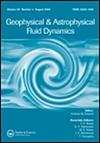具有理想底地形的浅水波的半解析解
IF 1.1
4区 地球科学
Q3 ASTRONOMY & ASTROPHYSICS
Geophysical and Astrophysical Fluid Dynamics
Pub Date : 2023-01-02
DOI:10.1080/03091929.2023.2169283
引用次数: 2
摘要
分析具有理想底部地形的二维浅水方程在大气和海洋科学中有许多应用;然而,为了得到明确的解决方案,已经做出了限制性流型假设。这项工作采用阿多米安分解法(ADM)来开发这些问题的半解析公式,这些公式在捕捉非线性现象的同时保留了物理参数的直接相关性。此外,我们利用这些技术作为逆向工程机制来开发公开文献中一些流行的ansatz公式之间的关键联系,并推导出具有有限逃离时间的地转惯性振荡和反气旋涡旋的精确解的新系列。我们的半分析评估表明,这种方法在提供针对几种海洋变化和海底地形的稳健近似方面具有前景,同时还保留了物理参数(如弗劳德数、海底地形、科里奥利参数以及流动和自由表面行为)之间的直接相关性。我们的数值验证为这种方法提供了额外的证实,同时也说明了ADM也可以用来提供洞察力和推断尚未探索的新颖解决方案,这些解决方案可以用来表征各种类型的地球物理流动。本文章由计算机程序翻译,如有差异,请以英文原文为准。
Semi-analytical solutions of shallow water waves with idealised bottom topographies
Analysing two-dimensional shallow water equations with idealised bottom topographies have many applications in the atmospheric and oceanic sciences; however, restrictive flow pattern assumptions have been made to achieve explicit solutions. This work employs the Adomian decomposition method (ADM) to develop semi-analytical formulations of these problems that preserve the direct correlation of the physical parameters while capturing the nonlinear phenomenon. Furthermore, we exploit these techniques as reverse engineering mechanisms to develop key connections between some prevalent ansatz formulations in the open literature as well as derive new families of exact solutions describing geostrophic inertial oscillations and anticyclonic vortices with finite escape times. Our semi-analytical evaluations show the promise of this approach in terms of providing robust approximations against several oceanic variations and bottom topographies while also preserving the direct correlation between the physical parameters such as the Froude number, the bottom topography, the Coriolis parameter, as well as the flow and free surface behaviours. Our numerical validations provide additional confirmations of this approach while also illustrating that ADM can also be used to provide insight and deduce novel solutions that have not been explored, which can be used to characterise various types of geophysical flows.
求助全文
通过发布文献求助,成功后即可免费获取论文全文。
去求助
来源期刊

Geophysical and Astrophysical Fluid Dynamics
地学天文-地球化学与地球物理
CiteScore
3.10
自引率
0.00%
发文量
14
审稿时长
>12 weeks
期刊介绍:
Geophysical and Astrophysical Fluid Dynamics exists for the publication of original research papers and short communications, occasional survey articles and conference reports on the fluid mechanics of the earth and planets, including oceans, atmospheres and interiors, and the fluid mechanics of the sun, stars and other astrophysical objects.
In addition, their magnetohydrodynamic behaviours are investigated. Experimental, theoretical and numerical studies of rotating, stratified and convecting fluids of general interest to geophysicists and astrophysicists appear. Properly interpreted observational results are also published.
 求助内容:
求助内容: 应助结果提醒方式:
应助结果提醒方式:


